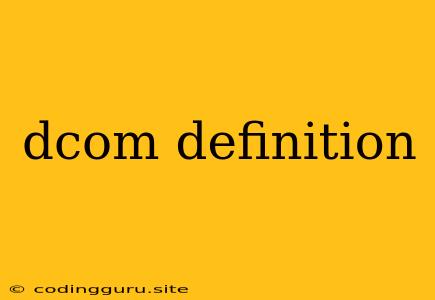What is DCOM and How Does It Work?
DCOM, or Distributed Component Object Model, is a technology that allows objects in one application to communicate with objects in another application, even if those applications are running on different computers. It is a powerful technology that enables developers to create distributed applications that can run on multiple machines.
How does DCOM work?
DCOM uses a client-server architecture. The client application is the application that makes requests to the server application. The server application is the application that provides the requested services.
When a client application wants to access an object in a server application, it first creates a proxy object. The proxy object is a local representation of the remote object. The client application then interacts with the proxy object as if it were the actual remote object.
The proxy object then communicates with the server application over the network. The server application receives the request, processes it, and returns the results to the client application.
What are the benefits of using DCOM?
There are several benefits to using DCOM, including:
- Improved modularity: DCOM allows developers to break down their applications into smaller, more manageable components. This makes applications easier to develop, test, and maintain.
- Enhanced reusability: DCOM components can be reused in multiple applications. This can save developers time and effort, and it can lead to more consistent application behavior.
- Greater scalability: DCOM allows applications to be scaled horizontally, by adding more servers to the network. This can help to improve performance and reliability.
- Increased interoperability: DCOM allows applications to communicate with each other, regardless of the programming language they were written in. This makes it easier to integrate applications from different vendors.
How is DCOM used in practice?
DCOM is used in a wide variety of applications, including:
- Enterprise resource planning (ERP) systems: DCOM is used to connect different modules within an ERP system, such as accounting, inventory, and sales.
- Customer relationship management (CRM) systems: DCOM is used to connect different CRM modules, such as sales, marketing, and customer service.
- Web services: DCOM can be used to expose objects as web services, making them accessible to other applications over the Internet.
What are some of the drawbacks of using DCOM?
Despite its benefits, DCOM also has some drawbacks, including:
- Complexity: DCOM can be complex to configure and manage. This can make it difficult to develop and deploy applications that use DCOM.
- Security concerns: DCOM can be a security risk, especially if it is not configured properly. It is important to take steps to secure DCOM applications, such as using strong passwords and enabling authentication.
- Limited platform support: DCOM is primarily supported by Microsoft Windows operating systems. It is not as widely supported on other operating systems, such as Linux and macOS.
Conclusion:
DCOM is a powerful technology that can be used to create distributed applications. However, it is important to be aware of the potential drawbacks before deciding to use it. If you are considering using DCOM, be sure to weigh the benefits and drawbacks carefully.
